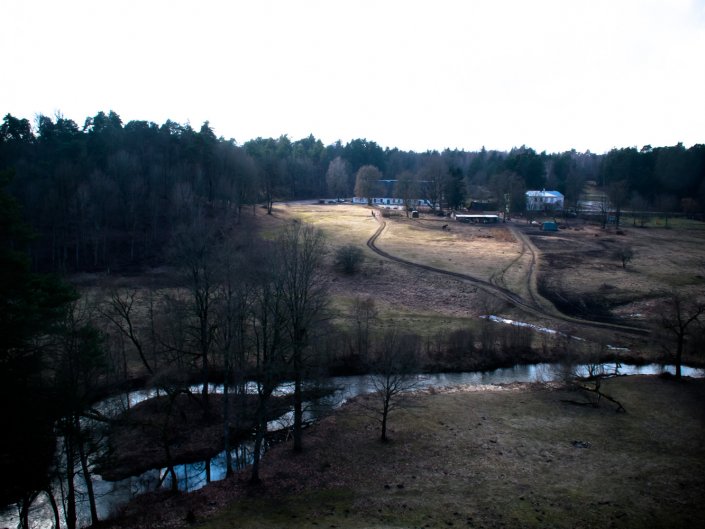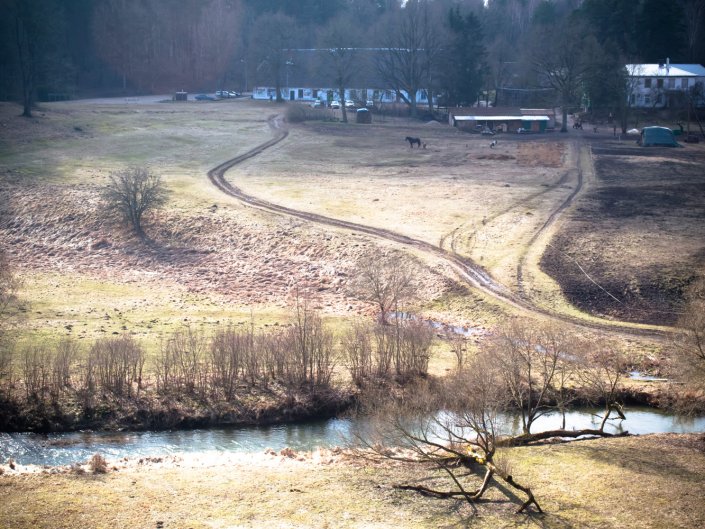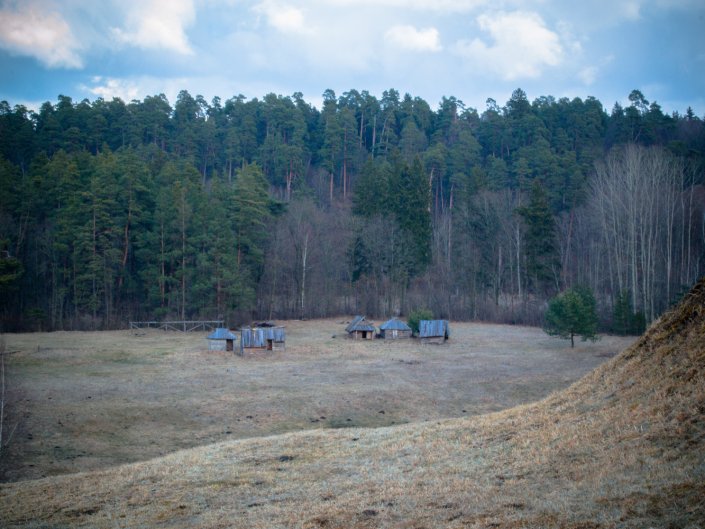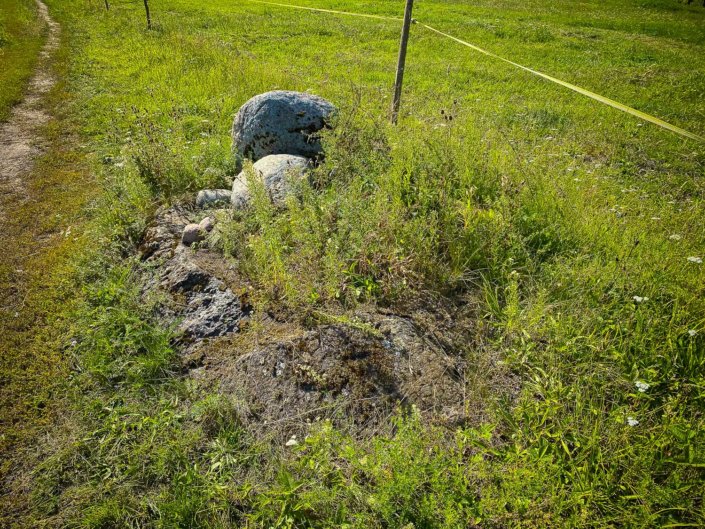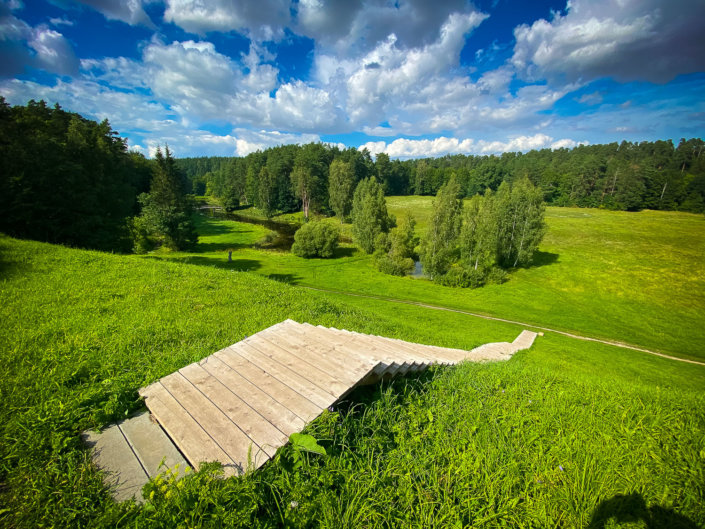Wikipedia on the hillfort
Tērvete hillfort (also known as Cukurkalns, “Sugar Hill”) is located in Tērvete village of the Tērvete municipality, on the right bank of the Tērvete river. Until the 13th century, the Semigallian rulers’ castle on this hill was the administrative centre of the Tērvete district. The mound and the ancient settlement are a state-protected archaeological monument.
The castle mound is a 19 m high hill with the surface area of 1000 m2, protected on the eastern side by 8 m high earthworks, ditch, and outer bailey. The total area of the ancient settlement at the Tērvete hillfort is estimated to have been ca. 10 hectares.
Archaeological excavations (1951-60) under the direction of Emīlija Brīvkalne found that the hillfort was fortified in the 11th-13th centuries when the northern side was extended and horizontal log wall and towers were constructed.
According to the Livonian Rhymed Chronicle, in the winter of 1259/60, the Master of the Livonian Order Burchard von Hornhausen led a crusade against Semigallians but failed to capture the Tērvete castle. In 1271, Master Walter von Nortecken led several attacks on Semigallia, seized the Tērvete castle, and forced the Semigallian leaders to sign a peace treaty. The Vogt of Tērvete took residence in the castle.
In 1279, Semigallian duke Nameisis allied with Traidenis, Grand Duke of Lithuania and liberated the Tērvete castle. Captured German knights were sent to Lithuania and the Vogt was sentenced to death. When in August 1281 Master Konrad von Feuchtwangen surrounded the castle with a 14 thousand strong force, Semigallians capitulated and agreed to pay taxes. However, soon they broke the truce and renewed hostilities.
After the death of Nameisis, the Livonian Order finally prevailed. In the winter of 1285/86, Master Wilken von Endorp built Heiligenberg castle on the Svētkalns hill of Tērvete, which housed a garrison of 300 knights headed by a Komtur. Samogitians together with Semigallians, using modern for the time military tactics, surrounded Heiligenberg castle mound in the winter of 1285. However, the knights of the Order successfully defended the castle.
E.Brastiņš on the hillfort

Survey scale 1:1000. Contour interval = 1m. Surveyed on July 28, 1923.

Section drawing of Cukurkalns, A to B. Scale 1:1000.
Cukurkalns (“Sugar Hill”) is the most notable hillfort of Zemgale. It is located next to Kalnamuiža, on the right bank of the Tērvete river. Together with its surrounding area, it is listed as a national historical monument. Cukurkalns mound was formed by cutting a 5 m deep ditch across a steep headland. The excavated soil was piled into an equally high mound, thus creating a 10 m artificial rise, which protects the eastern side of the hillfort. The remaining sides of the hillfort are naturally very steep and show no sign of artificial origin. The hilltop is relatively small, triangular. It is situated ca. 20 m above the river and adjacent meadows. A 3 m deep and 5 m wide pit is located near the northern edge of the hilltop and appears to be contemporaneous with the mound. Similar pits have been found in many other Latvian hillforts.

Plan of the Kalnamuiža area.
Years ago, Bielenstein found burnt cereal grains near the earthworks.
Cukurkalns is, without doubt, the location of the Tērvete castle, mentioned in ancient writings. The hillfort enclosure was supposedly positioned on the other side of the ditch, at the location of the current castle ruins, as evidenced by the cultural layer. A place called “Swedish Hill” is to the north of the Tērvete hillfort, across the meadow. Large ditches and earthworks are visible there but without any cultural layer. Supposedly it is the Heiligenberg fortress of the Livonian Order, which was built from timber and later dismantled.

Cukurkalns from the north-west.
A few hundred steps south of the Tērvete castle mound there is another artificial mound named Klosterkalns (“Monastery Hill”). It is a small, terraced hill. The true meaning of this place has not yet been researched, but it appears to be a burial mound.
Tērvete hillfort has been described in several texts by Bielenstein, Raison, Döring, etc. However, all these sources recount only chronicles of warfare that took place around this castle. Archaeologically, the Tērvete castle mound and its surrounding area are quite unexplored. Several folk legends have been recorded about Cukurkalns. For example, two girls are herding cows on the mound at noon. One of them finds a golden chain. She starts pulling the chain out of the ground. The chain keeps coming out of the ground until her lap is full so she cannot hold any more. She asks the other girl to come and help her. But at that moment the chain goes clanging back into the ground.
Brastiņš, E. Latvijas pilskalni. Vol. 2, Zemgale un Augšzeme. Riga, 1926




